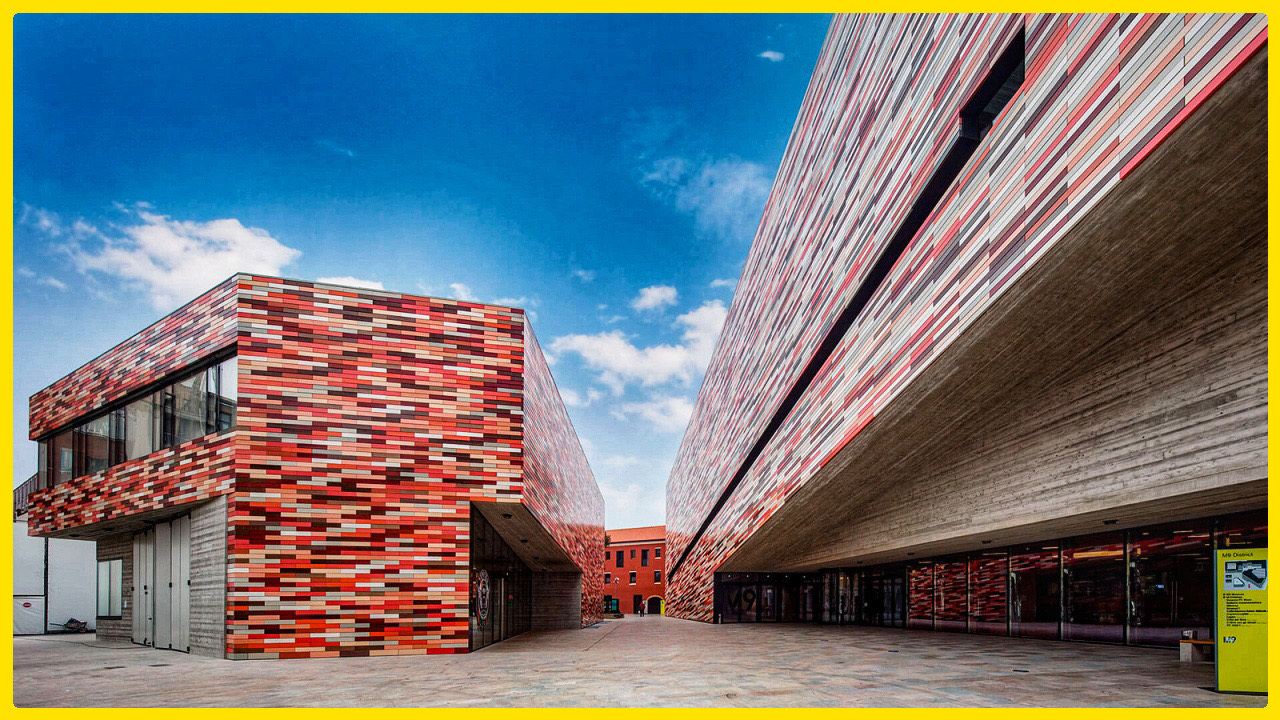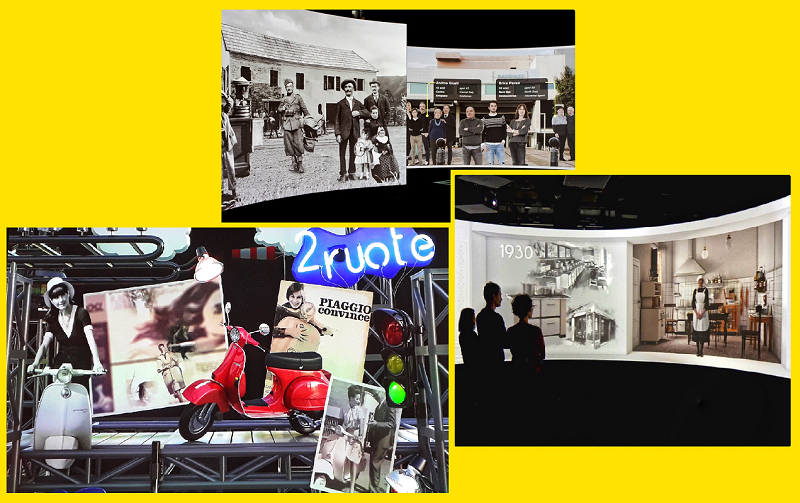Is it possible to tell the 20th century in a museum? In Mestre this is a reality thanks to the permanent exhibition of M9, Museo del Novecento. A place that fascinates inside and outside, a multimedia experience for young and old that allows you to take a journey into what the English historian Eric Hobsbawm called the short century.
It is therefore worth leaving Venetian calli and campielli for half a day and live this real adventure in time.
A smart city between ancient and modern

M9 is a museum dedicated to the history of the Italian 20th century that amazes you from the moment you arrive in its vicinity. This area in fact has a lot to tell and you can understand it from the different architectural styles, but in perfect harmony, that welcome visitors.
Entering from the arcades of Via Poerio, just behind Piazza Ferretto, we find ourselves in a cloister, now restored and brought back to life thanks to the commercial activities that arise there. Some contemporary architectural components do not diminish what remains of the Convento delle Grazie, dating back to the 16th century and which over time has undergone more transformations not only structural, but also of use. In a state of neglect for years, the area of the old building has therefore been chosen to give Mestre a museum and at the same time recover a central area of the city.
The part of the building that overlooks Via Poerio, in the heart of Mestre, has opted for a conservative restoration, while the inner part of the cloister has undergone a structural addition. A roof now makes it a suitable space in all weather conditions and therefore a place to stop for visitors or to meet those passing through.
Where the museum is located, it has been decided to create a completely new building, able to amaze for its shape and the polychromy of the ceramic tiles that completely cover the structure: a chromatic game that catalyse the attention, without doubt. Something original, unusual for the city of Mestre and able in this context to aesthetically create a total detachment with everything around, but with this around it blends in and dialogues with harmony.
It was 2010 when the Fondazione di Venezia launched an international competition for the design of M9. It was won by the German studio Sauerbruch Hutton with a proposal for an urban regeneration project that included a system of new and restored architecture that would integrate perfectly into the city.
M9 today is a real smart city thanks to the green choices for energy efficiency and environmental sustainability, as well as the widespread use of new technologies to offer innovative services to citizens and those who are just passing through Mestre.
Interesting the eco-sustainable choice to use raw materials with low environmental impact, the installation of 276 photovoltaic panels and a geothermal field with 63 probes that at a depth of 110 meters are able to produce 100% of the heating throughout the district.
So why an Italian 20th century museum?
To tell a story that is everyone's heritage and that has developed over time thanks to a series of small and large transformations that have taken place in daily life, in all its many aspects.
It has been decided to retrace, thanks to the tools offered by the most modern technology, the important moments that have marked and changed Italy and Italians from the point of view of social habits, but also of cultural, political and economic transformations.
In the M9 museum you will see few real objects, but a lot of multimedia and virtual experiences. The images become the protagonists of this exhibition space where all the senses are called to participate.
An experiential journey through history

One hundred years to discover in two floors and many experiences to live or relive moments and emotions that belong to us. It doesn't matter whether you are an adult, an old person or a child. M9 speaks to everyone in a different way allowing everyone to receive messages appropriate to their age.
The museum is divided into eight sections, all to be experienced as protagonists. One important thing: you are allow to touch!
- Come eravamo come siamo (The way we were and we are). The first section of the museum is of great impact: the visitor is greeted by curved screens and pictures of slowly moving group photos. This already immerses the visitor in a unique and surprising experience. Here we can understand in a simple and direct way the demographic, anthropometric and social changes of the Italian population in a period that goes from the phase after the Unification of Italy to today. A real journey through time to understand who we were, through the different changes that followed. How tall were we in the early 1900s? How did we dress in the 1930s? A series of multimedia experiences are able to tell us a lot.
- The Italian way of life. In this section you can see how consumption patterns, social rituals, but also personal care and home environments have changed during the twentieth century. The house is the protagonist of this section where among the most interesting experiences there is the possibility, thanks to virtual reality, to wander in a kitchen of the past. A special attention is focused on the design made in Italy, which is paid homage thanks to the installation of the dream house. And that's not all. In this section you can also reconstruct the evolution of the way Italians dress. From an essential home-made wardrobe to the great haute couture brands famous all over the world and proud for the whole country.
- La corsa al progresso (The race for progress). A fundamental story to understand how we have come so far in the field of technology thanks to the discoveries made over the last hundred years. A fitting tribute to the Italian genius and therefore to the scientists and innovators who have contributed to Italian and global technological development. A part is dedicated to means of transport (bicycles, trains, airplanes, motorcycles and cars) that have reduced travel times. A real revolution in transport that has shortened geographical distances. Get ready to be amazed to see inside a glass pyramid the hologram-shaped reproductions of Italian icons like the Vespa and Fiat 500.
- Soldi, soldi, soldi (Money Money Money). In the twentieth century goods and services, enjoyed by the average Italian, have grown more than eight times. The average income grew, mass consumption was born and the types of workers also changed. From a country mainly devoted to agriculture, Italy in the mid-1950s was linked to industrial production which went hand in hand with the growth of services until the 1970s. Then the so-called third industrial revolution that will see the birth of Small and Medium Enterprises and the expansion of services that in 2011 will occupy 70% of workers.
- Guardiamoci attorno (Let's look around). The economic and social transformations of the twentieth century have not only changed the habits of Italians, but also transformed the spaces in which we live and the landscape around us. A process of transformation that has seen the number of cities with over 100,000 inhabitants grow from 10 to 42 during the last century. A section that not only describes data but tells how the changes in the territory have occurred from the point of view of urban expansion and because of new habits and social functions, the evolution of mobility and economic development. An interesting path helped by multimedia to understand and deepen in an experiential way such a complex subject matter.
- Res-Public. In the 20th century Italy's protagonist was the square, a public space and at the same time a metaphor for belonging to a community of inhabitants. A century that experienced the passage from the Monarchy to the Republic through dictatorship and war and still strikes, demonstrations and parades. The common space of the square thus becomes a protagonist in the twentieth century for sharing moments of history and life. In this section it is a must to enter the political arena, an installation where the visitor in a virtual, but absolutely exciting way, is in the middle of the crowd to listen to the words of three characters who have marked the political history of the twentieth century and who here in the form of a hologram take turns talking from a balcony.
- Fare gli italiani. In an Italy rich in dialects, learning the national language and mass schooling accompanied a good slice of the last century. Just consider that at the time of the unification of Italy, in 1861, only 4 Italians out of 100 spoke Italian regularly and that in 1951 6 out of 10 still speak Italian only in dialect. An interesting journey between dialectal nuances, never completely dead, and the need for a common language that would allow them to understand each other.
- Per farci riconoscere (To make us recognize ourselves). What creates unity, what leads Italians to feel like members of one national community? An amusing section among stereotypes, habits, ways of saying and doing. Not only that, popular culture has also served as a glue among Italians, just think of the spread of television or sports events. To conclude the journey through time, we would like to highlight in particular the thematic area Alto e basso (High and Low). Here we talk about cinema, television, sport, newspapers. Music is not absent, in fact it has been thought for maybe the most amusing installation of the whole museum. A real disco made of mirrors and mirror balls with a juke box to retrace the different musical genres that have accompanied the history of the twentieth century.
The Italian twentieth century museum M9 has not had an easy life since it opened in December 2018.
However, there are many initiatives for its relaunch in this period as well as collateral activities organized within it. The third floor, for example, was created specifically to host temporary exhibitions. The last one currently underway is Lunar City, an exciting journey through the history of space travel between past and future. In the M9 calendar there are often also important meetings with personalities of culture and science hosted in the 200-seat auditorium, incorporated in the structure. A huge potential not yet fully understood. In fact, a multimedia museum in Italy is not yet a well-known and sufficiently appreciated reality as it is now abroad. A new challenge that will perhaps be told in a century in a museum that will host the Italian history of the last 200 years!
M9 is in Via Giovanni Pascoli 11, Mestre.










Lascia un commento